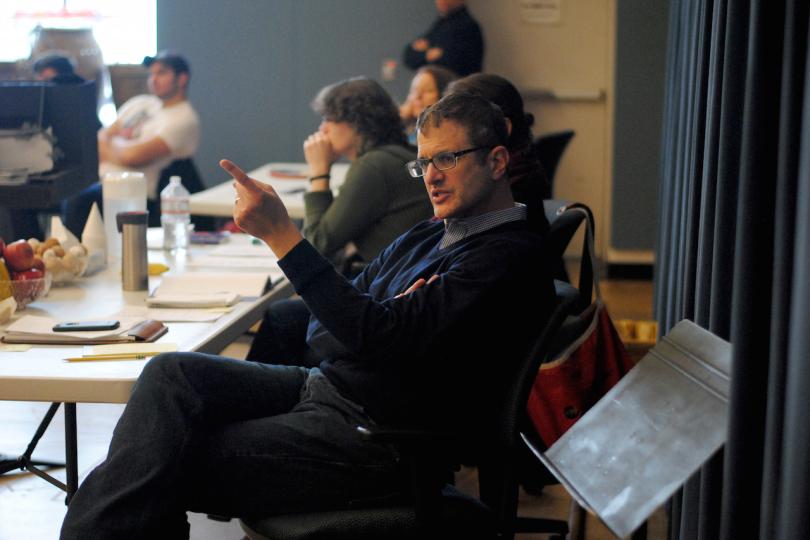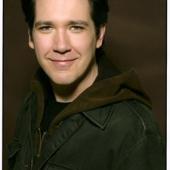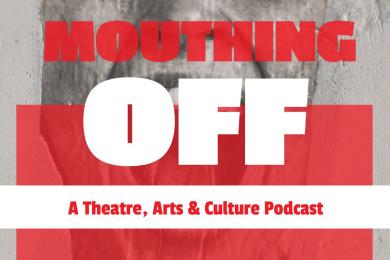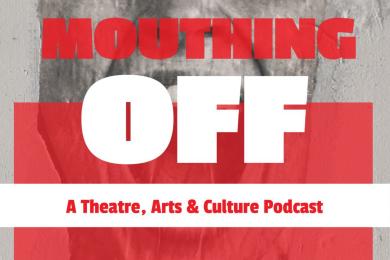Joseph Haj interview

Author's Introduction: A few weeks after I sat down to talk to the Guthrie's new Artistic Director, I was walking down a hallway toward one of the theater's rehearsal rooms. From a distance I could see something had changed but I wasn't quite sure what exactly it was. As I got closer I saw that the door was no longer a solid metal one but rather that a sizable window had been inserted into the door. Out of curiosity I walked to the other rehearsal room, and I saw the same change had been made there.
I wonder whether this kind of attention to detail tells us something more about the new Artistic Director. Can cutting a hole in a door say that a certain kind of openness and transparency are the order of the day? While the creation of art may occasionally require some privacy from the outside world, a window implies that the default position is one of welcome. Haj's attitude during this interview indicated that it's a position he is intent on achieving.
Knowing that Haj started out as an actor, I couldn’t resist asking him about those early days, and it turns out that it was during that time that he found himself transformed by his work on the old Guthrie stage.
As a young actor starting out, did you have any idea what the job of an artistic director was?
Good question. No. None at all. I had no idea what an artistic director did. And for the longest time I felt that everything I wanted to know about the art form, about myself, I could learn from being an actor. I was completely in that world. It was my total aspiration: I went to grad school for it, I loved it entirely.
When I look back at being a young actor, I think in some ways I was meant to be a director. I was never the kind of actor who got so far inside herself or himself that they needed to be led by the nose through the process. So I think my value to those rehearsal rooms and those directors was to understand what the director was suggesting we needed to pursue, and then tethering my imagination and my choices to those goals that the director set out. So, I think on some level I was always looking at a slightly bigger picture. Like, how can I help fulfill this larger thing, as opposed to, what did my character eat for breakfast. I was never that kind of actor. And we all know brilliant actors who come from that place, but that just wasn’t my thing.
And the artistic director thing came really quite late. I just became really interested in the question of what a community can mean to a theater and what a theater can mean to a community. And if you get really interested in those questions, artistic leadership is a logical next step through which to explore them.
How do you chart that progress from actor to director to artistic director? Are there distinct turning points? Is it a gradual process?
I was becoming the kind of actor, and I don’t know how to put this delicately, that none of us want to be. I got tired of explaining plays to bad directors. I just got tired. So I found that I was turning down work as an actor over and over and over again. Given the gigantic cost of making work, I had to feel confident that it was worth that cost to make a production of any particular play.
So in the late ‘90’s I was turning down a lot of work and it was my wife who said, If you don’t think anyone else can direct plays, you should really give it a go yourself. Because at that point there were only a handful of directors that I trusted could accurately reflect my work back to me. That’s all. I found that I simply wasn’t enjoying myself when I wasn’t in a process where I felt I wasn’t in really superb hands. And I had been blessed to have many, many wonderful experiences, so that all the others felt like barren exercises. I just stopped being interested.
I also remember feeling that at one time acting felt so big and holistic. Everything I wanted to know, experience, explore, was in that vertical of being an actor. And almost overnight, and I’m not sure I altogether understand why, it started feeling very narrow and specialized to me. I felt like a punter on a football team. I wanted more authorship of the event, I wanted the ability to say, I think this play is about these three things, and then build a production that pursues those things.
Interestingly, I’ve never felt like I’ve given up acting, I’d do it again in a minute if it was the right thing and if I had the time to do it. I love it entirely, it’s not like I’ve cut those things loose. But I find that acting, directing, artistic directing, producing other people’s work all fills the exact same part of me that needs to make theater. So if I’ve hired a director and I’m helping guide something they’re making through a process, that feels to me every bit as fulfilling as playing in something or directing something.
How do you characterize your aesthetic in the theater? And what sort of work excites you as an artist?
That’s probably a better question to ask others than me, in terms of my aesthetic.
But I guess I would say it is artist-centric, it is actor-centric. I believe strongly that style and form follows content. And I have almost ludicrously eclectic tastes when it comes to making plays. I can very happily make a production of As You Like It, and I have done, or Cabaret, and I can get as thrilled making an Ionesco play or a Lisa Kron play. I really genuinely love all these different strands, and they all require different skills. No matter whether you’re making a contemporary play or a Shakespeare play or a musical, they require that you put certain tools down and pick others up. And I love that exercise. As opposed to saying, these are my six tools and I make all plays with these. There are people who do that and do it so beautifully. Anne Bogart has a deliberately and strictly limited palette of tools with which she makes her beautiful work. That’s her choice and journey, and she’s an artist who I love and admire greatly.
Even within the same genre or form, the tools I needed to make a Pericles are very different from the tools I needed to make a Henry V or that I need to make an As You Like It. And then for all one’s desires about what one wants to make and how one wants to make it, then of course you’re crashing into other human beings who have their own ideas about what ought to be made. And so the part that’s about gathering and assembling a group of brilliant creative folks, and helping set a vision for what it is we’re going to make, in the end it’s not any different from leading a theater. Because basically you’re getting a group of people each with disparate talents, backgrounds, approaches, and you’re trying to get everyone to come together in common cause to make whatever it is you’re making. How do you have enough rigor that everyone understands what’s being chased, and how do you have enough elasticity that allows for other magnificent minds to come in and chart the course?
I don’t think I answered your question.
I bet someone who saw a production of mine could look at it and say, that’s a show of Joe’s, but I couldn’t tell you what the things are that make them say that.
Who or what made you a theater artist?
I’d say that my high school drama teacher opened a window for me and showed me that theater existed. I was a senior in high school, and I’d never seen a play. Or maybe I’d seen two bad plays. It just was not in my world. And I’ve had many teachers along the way who taught me more about it and about how to be an actor, a reasonably good one.
But it was in coming to the Guthrie and doing JoAnne Akalaitis’ production of The Screens that I realized what the art making was. All these years later, that for me is the yardstick by which all is measured. The bravery, the courage, the reach, the great ambition, the gigantically talented artists who were part of that team that made that play, the artistic leadership that allowed for five hours of Genet to actually take place. I think I was an actor before that and working hard to be a theater professional, and I think I came out of The Screens with the desire to be an artist.
This sounds so naïve all these years later, but at the time – I was a young actor, just out of training, maybe 24 years old when I got the call to come out here; I had been doing summer stock out in Maine for a couple hundred bucks a week – I did The Screens and it was the first time I understood that theater could carry meaning deeper and broader than story. I was a well-trained young actor, I knew how to communicate those stories, I could do that, I could fight and handle language, all those things that young actors are asked to do in order to work. But learning what the goal was, the aesthetics around it, all that – I could point to various spots along the journey, but none more important than that one.
That was a signal moment for me. It was the difference between hustling and getting work and what it is I wanted to be and do and try to accomplish. It was seminal for me.
Can you spell out what that thing is, which is beyond story and narrative, that is the aim and goal you’re pursuing?
I say this as a person who absolutely loves narrative, truly, it’s why I love Dickens as much as I do. But there are artists who understand, whether it’s Robert Woodruff’s Skin of our Teeth or JoAnne’s Screens, you know, I can stay at home and read those plays. I don’t come to the theater just to have the story told to me again. Coming to the theater and watching great artists use all the tools at their disposal to tell a story – gestural movement, language, how they compose the space (at which Garland Wright was a straight up genius), all these things that are a visual way to get the story across, and then what are costumes doing, what are lights doing, what is sound doing – artists who use all those tools are creating a broader, deeper experience for audiences. There are artists who simply know how to use all of those tools.
There are a million stories, and I keep coming back to JoAnne and The Screens, but there you had gigantic, fully formed artists at every position. So people didn’t come to see five hours of Genet just to say they survived it, you came with people who 25 years later say, I remember The Screens. I tell this story a lot because it’s important for us to remember as an organization. That show had three dozen Equity actors, it had the Electric Airport Orchestra, it had world class designers none of whom worked for free, and we rehearsed for 10 and a half weeks. It ran two and a half weeks off subscription. You don’t even need the back of an envelope to know how totally fucked from an economic standpoint such a thing was.
And then Jack Kroll in Newsweek, back when we used to read magazines, said it’s the most important piece of theater in the last 25 years in this country. And for the next five years, every artist in the country wanted to work at the Guthrie. So the idea that the artistic leadership at a major American institution, at a time when the economies were just as fragile if not more so than they are now, that’s an organization whose leadership said, we’re going to save our… As the story’s been told to me, when Garland first reached out to JoAnne and said, what do you want to do, she said The Screens, and he said, no, not yet. So he invited her to do Leon & Lena (and lenz), the Guthrie saved their pennies and a few years later they invited her to do The Screens. They had an investment there, to see that a piece of art got made, knowing that it was an impossibility that it would ever earn out.
But it was a super important moment for the Guthrie, put the Guthrie meaningfully back on the map. And it was followed by the History Plays, big gestures, big events that put the Guthrie in the national spotlight in ways that paid dividends years later. So I’m looking for ways that we can include in our work going forward those big gestures.
One way an artistic director puts his or her stamp on an organization is by choosing the artists who come in and collaborate and produce at the theater. Who are some of the artists or kinds of artists you want to have at the Guthrie?
I am very, very interested in ensuring that we have a plurality of voices among our directors and indeed the creative team, so I’m thinking director, I’m thinking playwright, I’m thinking scenic, costumes, lights, the whole team, leaving aside actors for a second. It’s really important to me that those teams be plural. So in that diversity I’m looking at gender equity, I’m looking at people of color all being invited to the table, but I’m also looking at aesthetic difference.
I make the plays I make in the way I know how to make them. I don’t need every director who comes here to merge narrowly with my aesthetics, and in fact, it’s very good and healthy for a theater when there are people who are making work that looks nothing like the artistic director’s work. One of the great dangers, and we see it in the American theatre all the time, is when artistic directors choose other directors who think exactly like them. And it’s the most natural thing! You get excited about people who you tune to in a certain way.
So part of the job, I think, is to cool that down, and say, a person who works like this could be really good for this project, and someone who works in this sphere could be really interesting in this project. Making sure we slow that down and ensuring we have aesthetic difference in the season is a priority.
Do you think the Guthrie can be an incubator for devised work?
I think it will be.
At Playmakers we supported devising companies meaningfully with support from the Mellon Foundation. I went to Mellon and I said, I’ve got some of the best rehearsal facilities in the country, I’ve got an outstanding administrative staff, I’ve got great shops, why can’t we do for devising companies what we do in the LORT world? Which is simply (when we’re doing our job well) we’re providing resources and we’re moving obstacles out of the way so artists can be successful. That’s it. That’s sort of the job!
And devising companies suffer mightily, because, unlike in the LORT circumstance, if you and I are doing a play together, I’m paying you from the first rehearsal. So I’m paying you to make the piece, not just perform it. Devising companies don’t see first dollar until the work is finished and somebody has bought it. They’re rushed, they have to go faster than they can go, they don’t have the money to invest in the R&D side, you’re juggling schedules so people can work their day jobs. So I went to Mellon and I said, you take care of the salary thing, I can house them, I can give them administrative support.
And over the years we’ve had SITI, we’ve had the TEAM, the Rude Mechs, Elevator Repair Service. Jeff Meanza, my Associate Artistic Director and I have successfully sought support for those kinds of companies for six years at Playmakers. It’s a really important thing. They’re making some of the most important work in the world, in the way that our edges become our center. We need to figure out a way to support those voices and those artists. I’m eager to continue that, or find a similar program here.
It’s about service to the field.
If you could change one thing about the way our art and industry works, what would you change?
I would change how much we each feel that the work we’re making is the only work worth making. I would change how poorly we behave toward one another in this field. And it comes from a scarcity mindset, of course. That mindset can put us in a place where we feel that anything that is good for you must be bad for me. I’ve been saying this for years. This sort of fundamentalism that our work is then only worthwhile work hurts us. We do terrific harm to each other as artists, as people, as organizations. I don’t like it. The fact that critics and others take potshots, that is something that must be survived, but the way we treat one another, if I could change one thing I’d change that. Because I think the field would flourish still further, if we could get rid of all that.




